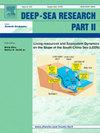Tsunami hazard assessment in the Persian Gulf: Evaluating near-field and far-field sources
IF 3
3区 地球科学
Q2 OCEANOGRAPHY
Deep-sea Research Part Ii-topical Studies in Oceanography
Pub Date : 2025-07-26
DOI:10.1016/j.dsr2.2025.105519
引用次数: 0
Abstract
Despite the relatively low probability of tsunamis in the Persian Gulf, the region's strategic importance necessitate a comprehensive risk assessment. This study evaluates both near-field and far-field tsunami sources affecting the Persian Gulf using numerical modeling based on nonlinear shallow-water equations. The Kazerun Fault system, recently identified as extending into the Gulf, is analyzed as a local tsunami source, while the maximum probable earthquake of the Makran subduction zone is considered the primary distant threat. Bathymetric influences are assessed by simulating near-field scenarios with both actual depth data and artificially deepened basin configurations.
Simulations reveal that for an Mw 7.9 earthquake, pure thrust faulting along the Kazerun Fault generates a tsunami with wave heights of up to 3 m, whereas purely strike-slip mechanisms yield negligible amplitudes (<0.3 m). While most coastal zones under actual bathymetry exhibit lower wave heights than deepened scenarios, localized areas show comparable or greater amplitudes. These findings challenge the assumption that shallow bathymetry inherently limits tsunami impacts in the Persian Gulf, demonstrating that depth-related attenuation alone cannot ensure immunity. Far-field modeling indicates that, despite precise modeling using nested bathymetry grids and accounting for non-uniform slip distributions to capture worst-case scenarios, Makran tsunami waves entering the Persian Gulf remain below 0.5 m, aligning with prior studies. This suggests that the Gulf's interior shores are largely protected against tsunamis originating from the Makran subduction zone. However, this work underscores the necessity of reevaluating local tsunami sources, particularly the offshore segments of the Kazerun Fault.
波斯湾海啸危害评估:评估近场和远场震源
尽管波斯湾发生海啸的可能性相对较低,但该地区的战略重要性需要进行全面的风险评估。本文采用基于非线性浅水方程的数值模拟方法对影响波斯湾的近场和远场海啸源进行了评价。最近发现的延伸到墨西哥湾的卡泽伦断层系统被分析为当地海啸的来源,而马卡伦俯冲带的最大可能地震被认为是主要的遥远威胁。通过模拟具有实际深度数据和人工加深盆地配置的近场情景来评估水深影响。模拟表明,对于7.9级地震,沿卡泽伦断层的纯逆冲断层产生的海啸浪高可达3米,而纯走滑机制产生的振幅可忽略不计(0.3米)。虽然在实际水深测量下,大多数沿海地区的波高低于加深情景,但局部地区的波高相当或更大。这些发现挑战了浅层测深固有地限制波斯湾海啸影响的假设,表明仅与深度相关的衰减不能确保免疫。远场模拟表明,尽管使用嵌套测深网格进行精确建模,并考虑到不均匀滑动分布以捕捉最坏情况,但进入波斯湾的Makran海啸波仍低于0.5米,与先前的研究一致。这表明墨西哥湾的内陆海岸在很大程度上受到了保护,免受来自马克兰俯冲带的海啸的侵袭。然而,这项工作强调了重新评估当地海啸来源的必要性,特别是卡泽伦断层的近海部分。
本文章由计算机程序翻译,如有差异,请以英文原文为准。
求助全文
约1分钟内获得全文
求助全文
来源期刊
CiteScore
6.40
自引率
16.70%
发文量
115
审稿时长
3 months
期刊介绍:
Deep-Sea Research Part II: Topical Studies in Oceanography publishes topical issues from the many international and interdisciplinary projects which are undertaken in oceanography. Besides these special issues from projects, the journal publishes collections of papers presented at conferences. The special issues regularly have electronic annexes of non-text material (numerical data, images, images, video, etc.) which are published with the special issues in ScienceDirect. Deep-Sea Research Part II was split off as a separate journal devoted to topical issues in 1993. Its companion journal Deep-Sea Research Part I: Oceanographic Research Papers, publishes the regular research papers in this area.

 求助内容:
求助内容: 应助结果提醒方式:
应助结果提醒方式:


